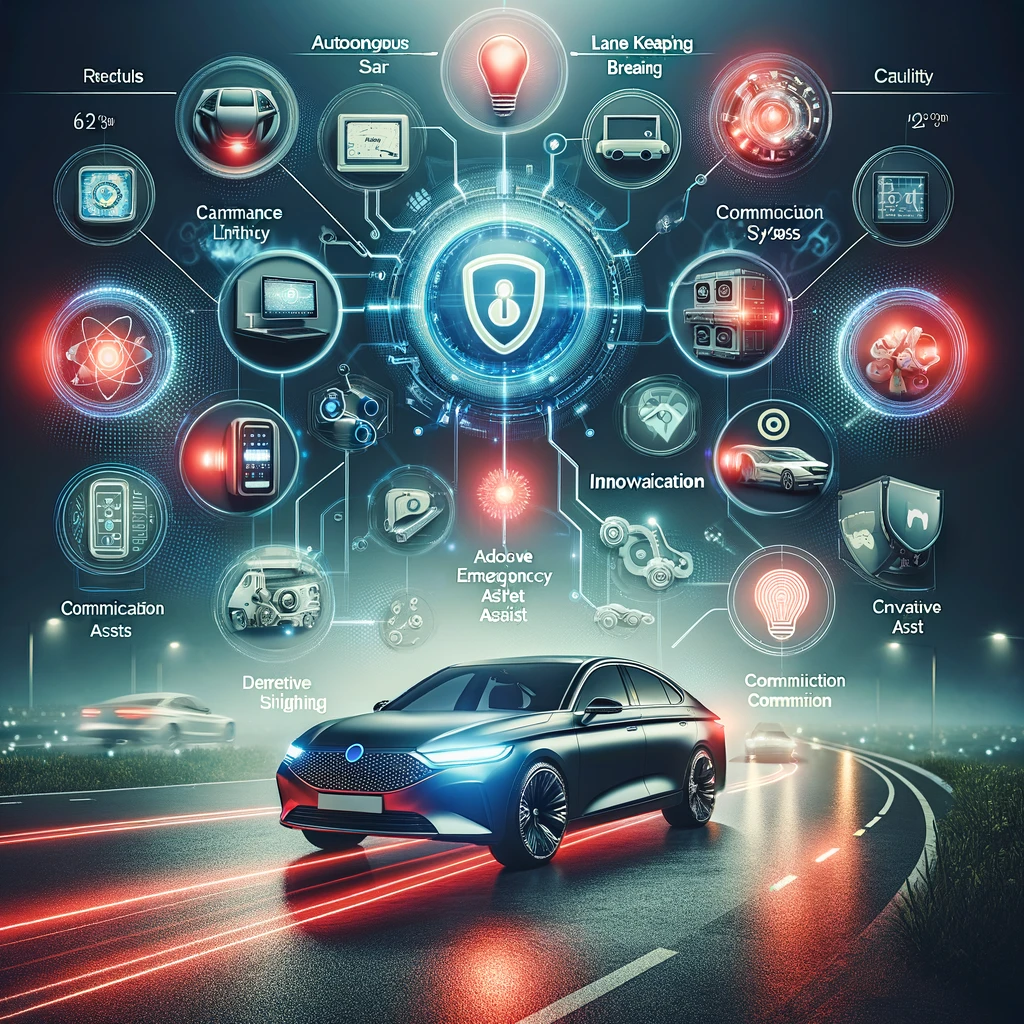As we navigate through the 21st century, the automotive industry has witnessed unprecedented technological advancements that have not only transformed the way we drive but significantly enhanced vehicle safety. The last decade, in particular, has been pivotal in introducing a range of innovative safety features, marking a new era in automotive design and engineering. From the integration of Advanced Driver-Assistance Systems (ADAS) to the development of fully autonomous vehicles, technology has become a driving force in reducing road accidents and fatalities.
This journey towards safer driving began with the implementation of basic safety features and has evolved into a sophisticated network of systems that work in harmony to protect passengers and pedestrians alike. Today, cars are not just modes of transportation; they are intelligent machines equipped with sensors, cameras, and algorithms designed to anticipate and react to potential hazards on the road.
The impact of these technological advancements on car safety is profound. Studies show a significant decrease in road accidents and injuries in vehicles equipped with these cutting-edge features. But how did we get here, and what can we expect in the future? This post delves into the evolution of car safety technology over the past decade, highlighting key innovations that have paved the way for a safer driving experience and speculating on future trends that promise to further revolutionize the automotive landscape.
As we explore these developments, it’s clear that technology’s role in enhancing car safety is invaluable. The advancements of the last decade have laid the groundwork for a future where road accidents may become increasingly rare, thanks to the relentless innovation and dedication of the automotive industry to making driving safer for everyone.
Evolution of Safety Technology
The past decade has seen a dramatic transformation in car safety technology, moving from passive systems designed to protect occupants in the event of an accident to active systems aimed at preventing accidents before they occur. Here’s a closer look at this evolution:
Early 2010s: The Foundations of Safety Technology
At the dawn of the 2010s, the automotive industry began to standardize features that once were considered premium, such as Electronic Stability Control (ESC) and Anti-lock Braking Systems (ABS). These technologies laid the groundwork for more advanced safety systems, focusing on preventing accidents from happening in the first place.
Mid-2010s: Advanced Driver-Assistance Systems (ADAS) Take Center Stage
As we moved into the mid-2010s, ADAS became more prevalent in vehicles across all price points. Technologies such as Autonomous Emergency Braking (AEB), Lane Departure Warnings (LDW), and Adaptive Cruise Control (ACC) started to become standard in many models. These systems use sensors and cameras to monitor the vehicle’s surroundings, providing drivers with real-time information and, in some cases, taking control of the vehicle to avoid potential hazards.
“The introduction of ADAS marked a significant shift in automotive safety, focusing on preventing accidents rather than just mitigating their effects,” notes automotive safety expert Dr. Emily Watson.
Late 2010s to Present: The Rise of Semi-Autonomous and Connected Vehicles
In the latter part of the decade, the focus shifted towards semi-autonomous driving features and the integration of vehicles into the wider digital ecosystem. Features like self-parking, traffic jam assist, and advanced navigation systems that communicate with traffic infrastructure became more common, enhancing both safety and driving convenience.
Moreover, the advent of Vehicle-to-Everything (V2X) communication has begun to unlock new possibilities in safety, allowing vehicles to communicate with each other and with road infrastructure to anticipate and avoid potential dangers.
A Quote to Ponder
“As we look towards the future, it’s clear that the integration of AI and machine learning into vehicle safety systems will play a pivotal role in achieving the vision of zero road fatalities,” reflects Dr. Watson.
This era of rapid innovation in car safety technology has not only made vehicles safer but has fundamentally changed the relationship between driver, vehicle, and the road. The advancements over the past decade are just the beginning, with future developments poised to deliver even greater levels of safety and redefine our concept of driving.
Key Technologies Shaping Car Safety
The advancements in car safety over the last decade can largely be attributed to several key technologies. These innovations have set new standards in automotive safety, significantly reducing the risk of accidents and enhancing the overall driving experience. Let’s explore some of the pivotal technologies that have been shaping car safety:
Autonomous Emergency Braking (AEB)
AEB systems have become a cornerstone of modern car safety, capable of detecting an impending collision with another vehicle, pedestrian, or obstacle and automatically applying the brakes to prevent or mitigate the accident. This technology has been particularly effective in reducing rear-end collisions.
“A moment’s distraction can lead to a lifetime of regret. AEB technology acts as an ever-vigilant co-pilot, ready to intervene when human reaction times are not fast enough,” states automotive safety advocate, James O’Connor.
Lane Keeping Assist (LKA) and Lane Departure Warning (LDW)
LKA and LDW systems work to prevent accidents caused by vehicles drifting out of their lanes, whether due to driver distraction, drowsiness, or incorrect judgment. By monitoring road markings, these systems can alert drivers to unintentional lane departures or even autonomously steer the vehicle back into the correct lane.
Adaptive Lighting Systems
The evolution of car lighting, including adaptive LED and laser headlights, has significantly improved nighttime driving safety. These intelligent lighting systems adjust the beam pattern based on driving conditions, speed, and other vehicles on the road, enhancing visibility without dazzling oncoming traffic.
Vehicle-to-Everything (V2X) Communication
V2X technology represents a leap forward in automotive safety, enabling vehicles to communicate with each other, with traffic infrastructure, and with other road users, such as pedestrians and cyclists. This interconnectedness allows for advanced warning of potential hazards, traffic conditions, and even the actions of other drivers, paving the way for more predictive and adaptive safety measures.
A Quote to Reflect On
“In an age where connectivity is king, V2X technology transforms every vehicle into a node in a vast network of safety, dramatically expanding the horizon of what’s possible in accident prevention,” highlights tech innovator, Sophia Chen.
These technologies showcase the automotive industry’s commitment to leveraging cutting-edge innovations to make driving safer for everyone. By continuously improving and integrating these systems, manufacturers are not just enhancing vehicle safety; they are also taking significant strides towards the future of fully autonomous driving, where the vision of zero accidents could one day become a reality.
The Role of Connectivity and Data
In the realm of car safety, connectivity and data analytics have emerged as game-changers, offering unprecedented opportunities to enhance vehicle safety and prevent accidents. The integration of connected services and the use of big data are not just improving individual vehicle safety; they’re revolutionizing the entire driving ecosystem.
Connected Services: Today’s vehicles are more than just machines; they’re part of an interconnected digital world. Services such as real-time traffic updates, hazard alerts, and vehicle diagnostics provide drivers with vital information to make safer driving decisions. Additionally, telematics data can be used to monitor driver behaviour, vehicle health, and even predict maintenance issues before they lead to breakdowns.
Big Data and Predictive Analytics: The vast amounts of data collected from connected vehicles are being analyzed to uncover patterns, predict potential hazards, and develop new safety features. For instance, predictive analytics can anticipate possible collisions and alert drivers or autonomous systems to take preventive action.
“The fusion of connectivity and data is setting the stage for a future where vehicles not only communicate with each other but also anticipate and react to dangers before they even occur,” notes data scientist, Dr. Liam Patel.
Future Trends and Innovations
As we look forward, several emerging trends and innovations promise to further enhance car safety:
- Fully Autonomous Vehicles: The ultimate goal of automotive technology is the development of fully autonomous vehicles. These self-driving cars, equipped with advanced sensors and AI, could drastically reduce human error, the leading cause of road accidents.
- Augmented Reality Dashboards: AR dashboards display vital information directly onto the windshield, allowing drivers to keep their eyes on the road while still accessing navigation, hazard warnings, and vehicle status updates.
- Advanced Biometric Systems: Future vehicles may use biometric technology to enhance safety and security, including systems that monitor driver alertness, heart rate, and even blood alcohol levels to prevent impaired driving.
Conclusion
Over the past decade, the impact of technology on car safety has been profound and far-reaching. As we’ve explored, advancements in ADAS, connectivity, and data analytics have paved the way for safer roads and saved countless lives. The future holds even greater promise, with the potential for fully autonomous vehicles and other innovative technologies to create a world where road accidents are a rarity rather than a common occurrence.
As we embrace these technological advancements, it’s clear that the journey towards safer driving is an ongoing process, one that requires the collaboration of automakers, technology companies, policymakers, and drivers themselves. Together, we can continue to push the boundaries of what’s possible in automotive safety, ensuring that every journey is safe, secure, and enjoyable.
“The road ahead is bright, with technology lighting the way towards unprecedented levels of safety and security on our roads,” reflects automotive safety expert, James O’Connor. As we move forward, the role of technology in car safety will undoubtedly continue to evolve, marking a new era in the way we think about driving, safety, and mobility.






